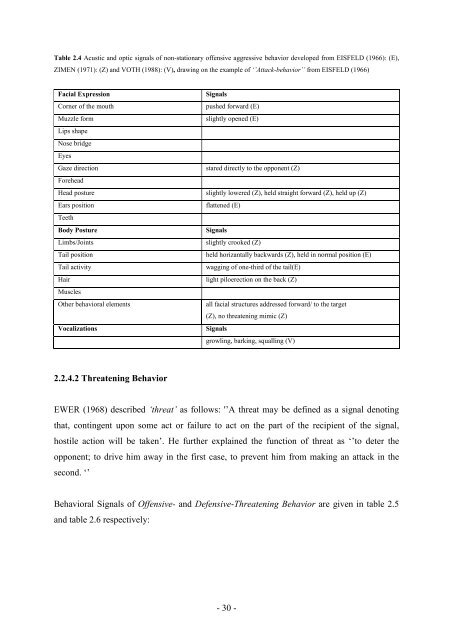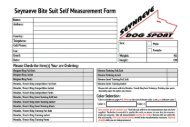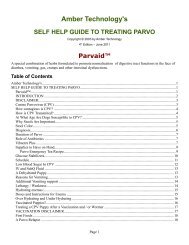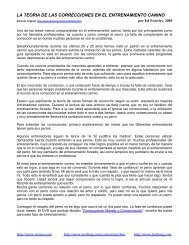Comparison of Stress and Learning Effects of Three Different ...
Comparison of Stress and Learning Effects of Three Different ...
Comparison of Stress and Learning Effects of Three Different ...
Create successful ePaper yourself
Turn your PDF publications into a flip-book with our unique Google optimized e-Paper software.
Table 2.4 Acustic <strong>and</strong> optic signals <strong>of</strong> non-stationary <strong>of</strong>fensive aggressive behavior developed from EISFELD (1966): (E),<br />
ZIMEN (1971): (Z) <strong>and</strong> VOTH (1988): (V), drawing on the example <strong>of</strong> ‘’Attack-behavior’’ from EISFELD (1966)<br />
Facial Expression Signals<br />
Corner <strong>of</strong> the mouth pushed forward (E)<br />
Muzzle form slightly opened (E)<br />
Lips shape<br />
Nose bridge<br />
Eyes<br />
Gaze direction stared directly to the opponent (Z)<br />
Forehead<br />
Head posture slightly lowered (Z), held straight forward (Z), held up (Z)<br />
Ears position flattened (E)<br />
Teeth<br />
Body Posture Signals<br />
Limbs/Joints slightly crooked (Z)<br />
Tail position held horizantally backwards (Z), held in normal position (E)<br />
Tail activity wagging <strong>of</strong> one-third <strong>of</strong> the tail(E)<br />
Hair light piloerection on the back (Z)<br />
Muscles<br />
Other behavioral elements all facial structures addressed forward/ to the target<br />
Vocalizations Signals<br />
2.2.4.2 Threatening Behavior<br />
(Z), no threatening mimic (Z)<br />
growling, barking, squalling (V)<br />
EWER (1968) described ‘threat’ as follows: '’A threat may be defined as a signal denoting<br />
that, contingent upon some act or failure to act on the part <strong>of</strong> the recipient <strong>of</strong> the signal,<br />
hostile action will be taken’. He further explained the function <strong>of</strong> threat as ‘’to deter the<br />
opponent; to drive him away in the first case, to prevent him from making an attack in the<br />
second. ‘’<br />
Behavioral Signals <strong>of</strong> Offensive- <strong>and</strong> Defensive-Threatening Behavior are given in table 2.5<br />
<strong>and</strong> table 2.6 respectively:<br />
- 30 -














